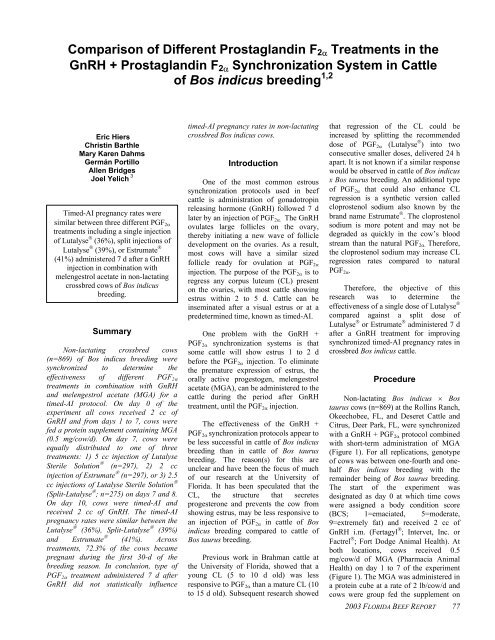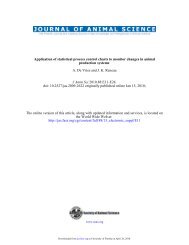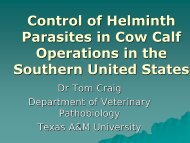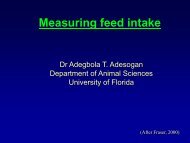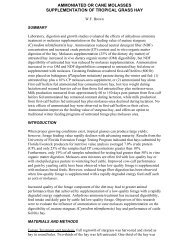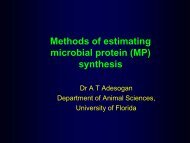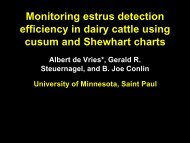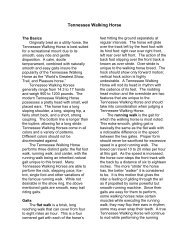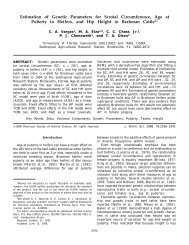Comparison of Different Prostaglandin F2α Treatments in the GnRH ...
Comparison of Different Prostaglandin F2α Treatments in the GnRH ...
Comparison of Different Prostaglandin F2α Treatments in the GnRH ...
Create successful ePaper yourself
Turn your PDF publications into a flip-book with our unique Google optimized e-Paper software.
<strong>Comparison</strong> <strong>of</strong> <strong>Different</strong> <strong>Prostagland<strong>in</strong></strong> F 2α <strong>Treatments</strong> <strong>in</strong> <strong>the</strong><br />
<strong>GnRH</strong> + <strong>Prostagland<strong>in</strong></strong> F 2α Synchronization System <strong>in</strong> Cattle<br />
<strong>of</strong> Bos <strong>in</strong>dicus breed<strong>in</strong>g 1,2<br />
Eric Hiers<br />
Christ<strong>in</strong> Barthle<br />
Mary Karen Dahms<br />
Germán Portillo<br />
Allen Bridges<br />
Joel Yelich 3<br />
Timed-AI pregnancy rates were<br />
similar between three different PGF 2α<br />
treatments <strong>in</strong>clud<strong>in</strong>g a s<strong>in</strong>gle <strong>in</strong>jection<br />
<strong>of</strong> Lutalyse ® (36%), split <strong>in</strong>jections <strong>of</strong><br />
Lutalyse ® (39%), or Estrumate ®<br />
(41%) adm<strong>in</strong>istered 7 d after a <strong>GnRH</strong><br />
<strong>in</strong>jection <strong>in</strong> comb<strong>in</strong>ation with<br />
melengestrol acetate <strong>in</strong> non-lactat<strong>in</strong>g<br />
crossbred cows <strong>of</strong> Bos <strong>in</strong>dicus<br />
breed<strong>in</strong>g.<br />
Summary<br />
Non-lactat<strong>in</strong>g crossbred cows<br />
(n=869) <strong>of</strong> Bos <strong>in</strong>dicus breed<strong>in</strong>g were<br />
synchronized to determ<strong>in</strong>e <strong>the</strong><br />
effectiveness <strong>of</strong> different PGF 2α<br />
treatments <strong>in</strong> comb<strong>in</strong>ation with <strong>GnRH</strong><br />
and melengestrol acetate (MGA) for a<br />
timed-AI protocol. On day 0 <strong>of</strong> <strong>the</strong><br />
experiment all cows received 2 cc <strong>of</strong><br />
<strong>GnRH</strong> and from days 1 to 7, cows were<br />
fed a prote<strong>in</strong> supplement conta<strong>in</strong><strong>in</strong>g MGA<br />
(0.5 mg/cow/d). On day 7, cows were<br />
equally distributed to one <strong>of</strong> three<br />
treatments: 1) 5 cc <strong>in</strong>jection <strong>of</strong> Lutalyse<br />
Sterile Solution ® (n=297), 2) 2 cc<br />
<strong>in</strong>jection <strong>of</strong> Estrumate ® (n=297), or 3) 2.5<br />
cc <strong>in</strong>jections <strong>of</strong> Lutalyse Sterile Solution ®<br />
(Split-Lutalyse ® ; n=275) on days 7 and 8.<br />
On day 10, cows were timed-AI and<br />
received 2 cc <strong>of</strong> <strong>GnRH</strong>. The timed-AI<br />
pregnancy rates were similar between <strong>the</strong><br />
Lutalyse ® (36%), Split-Lutalyse ® (39%)<br />
and Estrumate ® (41%). Across<br />
treatments, 72.3% <strong>of</strong> <strong>the</strong> cows became<br />
pregnant dur<strong>in</strong>g <strong>the</strong> first 30-d <strong>of</strong> <strong>the</strong><br />
breed<strong>in</strong>g season. In conclusion, type <strong>of</strong><br />
PGF 2α treatment adm<strong>in</strong>istered 7 d after<br />
<strong>GnRH</strong> did not statistically <strong>in</strong>fluence<br />
timed-AI pregnancy rates <strong>in</strong> non-lactat<strong>in</strong>g<br />
crossbred Bos <strong>in</strong>dicus cows.<br />
Introduction<br />
One <strong>of</strong> <strong>the</strong> most common estrous<br />
synchronization protocols used <strong>in</strong> beef<br />
cattle is adm<strong>in</strong>istration <strong>of</strong> gonadotrop<strong>in</strong><br />
releas<strong>in</strong>g hormone (<strong>GnRH</strong>) followed 7 d<br />
later by an <strong>in</strong>jection <strong>of</strong> PGF 2α. The <strong>GnRH</strong><br />
ovulates large follicles on <strong>the</strong> ovary,<br />
<strong>the</strong>reby <strong>in</strong>itiat<strong>in</strong>g a new wave <strong>of</strong> follicle<br />
development on <strong>the</strong> ovaries. As a result,<br />
most cows will have a similar sized<br />
follicle ready for ovulation at PGF 2α<br />
<strong>in</strong>jection. The purpose <strong>of</strong> <strong>the</strong> PGF 2α is to<br />
regress any corpus luteum (CL) present<br />
on <strong>the</strong> ovaries, with most cattle show<strong>in</strong>g<br />
estrus with<strong>in</strong> 2 to 5 d. Cattle can be<br />
<strong>in</strong>sem<strong>in</strong>ated after a visual estrus or at a<br />
predeterm<strong>in</strong>ed time, known as timed-AI.<br />
One problem with <strong>the</strong> <strong>GnRH</strong> +<br />
PGF 2α synchronization systems is that<br />
some cattle will show estrus 1 to 2 d<br />
before <strong>the</strong> PGF 2α <strong>in</strong>jection. To elim<strong>in</strong>ate<br />
<strong>the</strong> premature expression <strong>of</strong> estrus, <strong>the</strong><br />
orally active progestogen, melengestrol<br />
acetate (MGA), can be adm<strong>in</strong>istered to <strong>the</strong><br />
cattle dur<strong>in</strong>g <strong>the</strong> period after <strong>GnRH</strong><br />
treatment, until <strong>the</strong> PGF 2α <strong>in</strong>jection.<br />
The effectiveness <strong>of</strong> <strong>the</strong> <strong>GnRH</strong> +<br />
PGF 2α synchronization protocols appear to<br />
be less successful <strong>in</strong> cattle <strong>of</strong> Bos <strong>in</strong>dicus<br />
breed<strong>in</strong>g than <strong>in</strong> cattle <strong>of</strong> Bos taurus<br />
breed<strong>in</strong>g. The reason(s) for this are<br />
unclear and have been <strong>the</strong> focus <strong>of</strong> much<br />
<strong>of</strong> our research at <strong>the</strong> University <strong>of</strong><br />
Florida. It has been speculated that <strong>the</strong><br />
CL, <strong>the</strong> structure that secretes<br />
progesterone and prevents <strong>the</strong> cow from<br />
show<strong>in</strong>g estrus, may be less responsive to<br />
an <strong>in</strong>jection <strong>of</strong> PGF 2α <strong>in</strong> cattle <strong>of</strong> Bos<br />
<strong>in</strong>dicus breed<strong>in</strong>g compared to cattle <strong>of</strong><br />
Bos taurus breed<strong>in</strong>g.<br />
Previous work <strong>in</strong> Brahman cattle at<br />
<strong>the</strong> University <strong>of</strong> Florida, showed that a<br />
young CL (5 to 10 d old) was less<br />
responsive to PGF 2α than a mature CL (10<br />
to 15 d old). Subsequent research showed<br />
that regression <strong>of</strong> <strong>the</strong> CL could be<br />
<strong>in</strong>creased by splitt<strong>in</strong>g <strong>the</strong> recommended<br />
dose <strong>of</strong> PGF 2α (Lutalyse ® ) <strong>in</strong>to two<br />
consecutive smaller doses, delivered 24 h<br />
apart. It is not known if a similar response<br />
would be observed <strong>in</strong> cattle <strong>of</strong> Bos <strong>in</strong>dicus<br />
x Bos taurus breed<strong>in</strong>g. An additional type<br />
<strong>of</strong> PGF 2α that could also enhance CL<br />
regression is a syn<strong>the</strong>tic version called<br />
cloprostenol sodium also known by <strong>the</strong><br />
brand name Estrumate ® . The cloprostenol<br />
sodium is more potent and may not be<br />
degraded as quickly <strong>in</strong> <strong>the</strong> cow’s blood<br />
stream than <strong>the</strong> natural PGF 2α. Therefore,<br />
<strong>the</strong> cloprostenol sodium may <strong>in</strong>crease CL<br />
regression rates compared to natural<br />
PGF 2α .<br />
Therefore, <strong>the</strong> objective <strong>of</strong> this<br />
research was to determ<strong>in</strong>e <strong>the</strong><br />
effectiveness <strong>of</strong> a s<strong>in</strong>gle dose <strong>of</strong> Lutalyse ®<br />
compared aga<strong>in</strong>st a split dose <strong>of</strong><br />
Lutalyse ® or Estrumate ® adm<strong>in</strong>istered 7 d<br />
after a <strong>GnRH</strong> treatment for improv<strong>in</strong>g<br />
synchronized timed-AI pregnancy rates <strong>in</strong><br />
crossbred Bos <strong>in</strong>dicus cattle.<br />
Procedure<br />
Non-lactat<strong>in</strong>g Bos <strong>in</strong>dicus × Bos<br />
taurus cows (n=869) at <strong>the</strong> Roll<strong>in</strong>s Ranch,<br />
Okeechobee, FL, and Deseret Cattle and<br />
Citrus, Deer Park, FL, were synchronized<br />
with a <strong>GnRH</strong> + PGF 2α protocol comb<strong>in</strong>ed<br />
with short-term adm<strong>in</strong>istration <strong>of</strong> MGA<br />
(Figure 1). For all replications, genotype<br />
<strong>of</strong> cows was between one-fourth and onehalf<br />
Bos <strong>in</strong>dicus breed<strong>in</strong>g with <strong>the</strong><br />
rema<strong>in</strong>der be<strong>in</strong>g <strong>of</strong> Bos taurus breed<strong>in</strong>g.<br />
The start <strong>of</strong> <strong>the</strong> experiment was<br />
designated as day 0 at which time cows<br />
were assigned a body condition score<br />
(BCS; 1=emaciated, 5=moderate,<br />
9=extremely fat) and received 2 cc <strong>of</strong><br />
<strong>GnRH</strong> i.m. (Fertagyl ® ; Intervet, Inc. or<br />
Factrel ® ; Fort Dodge Animal Health). At<br />
both locations, cows received 0.5<br />
mg/cow/d <strong>of</strong> MGA (Pharmacia Animal<br />
Health) on day 1 to 7 <strong>of</strong> <strong>the</strong> experiment<br />
(Figure 1). The MGA was adm<strong>in</strong>istered <strong>in</strong><br />
a prote<strong>in</strong> cube at a rate <strong>of</strong> 2 lb/cow/d and<br />
cows were group fed <strong>the</strong> supplement on<br />
2003 FLORIDA BEEF REPORT 77
<strong>the</strong> ground under pasture conditions. On<br />
<strong>the</strong> last day <strong>of</strong> MGA feed<strong>in</strong>g (day 7 <strong>of</strong> <strong>the</strong><br />
experiment), cows were randomly<br />
assigned to one <strong>of</strong> three treatments with<strong>in</strong><br />
each location to receive ei<strong>the</strong>r 5 cc <strong>of</strong><br />
PGF 2α (Lutalyse Sterile Solution ® ), 2 cc<br />
<strong>of</strong> cloprostenol sodium (Estrumate ® ), or<br />
2.5 cc <strong>of</strong> PGF 2α (Split-Lutalyse Sterile<br />
Solution ® ) on days 7 and 8. Cows were<br />
timed-AI and received 2 cc <strong>of</strong> <strong>GnRH</strong><br />
approximately 72 to 80 h after <strong>the</strong> last<br />
MGA feed<strong>in</strong>g.<br />
Cows were exposed to bulls<br />
approximately 10 d follow<strong>in</strong>g timed-AI<br />
for a breed<strong>in</strong>g season <strong>of</strong> approximately 60<br />
d at all locations. Pregnancy status was<br />
determ<strong>in</strong>ed between 52 and 56 d after <strong>the</strong><br />
timed AI us<strong>in</strong>g a real-time B-mode<br />
ultrasound. The data presented <strong>in</strong> this<br />
paper <strong>in</strong>cludes timed-AI pregnancy<br />
(number <strong>of</strong> animals pregnant to <strong>the</strong> timed-<br />
AI divided by <strong>the</strong> number treated) and 30-<br />
d pregnancy rates (number <strong>of</strong> cows<br />
pregnant dur<strong>in</strong>g <strong>the</strong> first 30 d <strong>of</strong> <strong>the</strong><br />
breed<strong>in</strong>g season divided by <strong>the</strong> number<br />
treated).<br />
Results<br />
There was no statistical difference <strong>in</strong><br />
<strong>the</strong> timed-AI pregnancy rates between<br />
PGF 2α treatments (Figure 2). Although,<br />
5% more Estrumate ® treated cows and 3%<br />
more Split-Lutalyse ® cows became<br />
pregnant compared to <strong>the</strong> s<strong>in</strong>gle Lutalyse ®<br />
treatment. For <strong>the</strong> Estrumate ® treatment,<br />
this calculated to 15 extra pregnancies. A<br />
greater number <strong>of</strong> calves born <strong>in</strong> <strong>the</strong><br />
subsequent calv<strong>in</strong>g season could certa<strong>in</strong>ly<br />
have a positive economic benefit to a<br />
producer. Fur<strong>the</strong>rmore, <strong>the</strong> Estrumate ®<br />
treatment does not require <strong>the</strong> additional<br />
cattle handl<strong>in</strong>g required by <strong>the</strong> Split-<br />
Lutalyse ® treatment. Additional research<br />
will need to be conducted with an<br />
<strong>in</strong>creased number <strong>of</strong> cattle and <strong>in</strong><br />
postpartum lactat<strong>in</strong>g cows <strong>of</strong> Bos <strong>in</strong>dicus<br />
breed<strong>in</strong>g to determ<strong>in</strong>e if <strong>the</strong>se results can<br />
be replicated.<br />
The importance <strong>of</strong> body condition on<br />
reproductive function and breed<strong>in</strong>g season<br />
pregnancy rates has been well<br />
documented by scientists and beef<br />
producers. Body condition score can also<br />
<strong>in</strong>fluence <strong>the</strong> effectiveness <strong>of</strong><br />
synchronization protocols. In <strong>the</strong> present<br />
experiment, cows with a body condition<br />
score ≥5 had a 6% <strong>in</strong>crease <strong>in</strong> timed-AI<br />
pregnancy rates (Figure 3) compared to<br />
cows with a body condition score
Figure 2. Timed-AI pregnancy rates (number <strong>of</strong> cows pregnant to <strong>the</strong> timed-AI divided by <strong>the</strong> total treated) <strong>in</strong> non-lactat<strong>in</strong>g Bos<br />
<strong>in</strong>dicus × Bos taurus cows synchronized with <strong>GnRH</strong> + PGF 2α <strong>in</strong> comb<strong>in</strong>ation with melengestrol acetate. Numbers <strong>in</strong> paren<strong>the</strong>sis<br />
<strong>in</strong>dicate <strong>the</strong> numbers <strong>of</strong> cows <strong>in</strong> each treatment.<br />
45<br />
Lutalyse<br />
Percent pregnant<br />
40<br />
35<br />
Split-Lutalyse<br />
Estrumate<br />
36<br />
39<br />
41<br />
(297) (275) (297)<br />
30<br />
<strong>Treatments</strong><br />
Figure 3. Timed-AI pregnancy rates (number <strong>of</strong> cows pregnant to <strong>the</strong> timed-AI divided by <strong>the</strong> total treated) by body condition<br />
score (BCS; 1=emaciated, 5=moderate, 9=extremely fat) <strong>in</strong> non-lactat<strong>in</strong>g Bos <strong>in</strong>dicus × Bos taurus cows synchronized with<br />
<strong>GnRH</strong> + PGF 2α <strong>in</strong> comb<strong>in</strong>ation with melengestrol acetate. Numbers <strong>in</strong> paren<strong>the</strong>sis <strong>in</strong>dicate <strong>the</strong> number <strong>of</strong> cows with<strong>in</strong> each BCS<br />
category.<br />
45<br />
41<br />
Percent pregnant<br />
40<br />
35<br />
35<br />
30<br />
(412) (457)<br />
BCS < 5 BCS ≥ 5<br />
2003 FLORIDA BEEF REPORT 79
80 2003 FLORIDA BEEF REPORT


